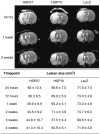Protective effect of post-ischaemic viral delivery of heat shock proteins in vivo
- PMID: 18781161
- PMCID: PMC2702130
- DOI: 10.1038/jcbfm.2008.106
Protective effect of post-ischaemic viral delivery of heat shock proteins in vivo
Abstract
Heat shock proteins (HSPs) function as molecular chaperones involved in protein folding, transport and degradation and, in addition, they can promote cell survival both in vitro and in vivo after a range of stresses. Although some in vivo studies have suggested that HSP27 and HSP70 can be neuroprotective, current evidence is limited, particularly when HSPs have been delivered after an insult. The effect of overexpressing HSPs after transient occlusion of the middle cerebral artery in rats was investigated by delivering an attenuated herpes simplex viral vector (HSV-1) engineered to express HSP27 or HSP70 30 mins after tissue reperfusion. Magnetic resonance imaging scans were used to determine lesion size and cerebral blood flow at six different time points up to 1 month after stroke. Animals underwent two sensorimotor tests at the same time points to assess the relationship between lesion size and function. Results indicate that post-ischaemic viral delivery of HSP27, but not of HSP70, caused a statistically significant reduction in lesion size and induced a significant behavioural improvement compared with controls. This is the first evidence of effective post-ischaemic gene therapy with a viral vector expressing HSP27 in an experimental model of stroke.
Figures





References
-
- Acarin L, Paris J, Gonzalez B, Castellano B. Glial expression of small heat shock proteins following an excitotoxic lesion in the immature rat brain. Glia. 2002;38:1–14. - PubMed
-
- Akbar MT, Lundberg AMC, Liu K, et al. The neuroprotective effects of heat shock protein 27 over-expression in transgenic animals against kainate-induced seizures and hippocampal cell death. J Biol Chem. 2003;278:19956–65. - PubMed
-
- Alsop DC, Detre JA. Reduced transit-time sensitivity in non-invasive magnetic resonance imaging of human cerebral blood flow. J Cereb Blood Flow Metab. 1996;16:1236–49. - PubMed
-
- Aron Badin R, Lythgoe MF, van der Weerd L, et al. Neuroprotective effects of virally delivered HSPs in experimental stroke. J Cereb Blood Flow Metab. 2006;26:371–81. - PubMed
-
- Aronowski J, Samways E, Strong R, Rhoades HM, Grotta JC. An alternative method for the quantitation of neurological damage after experimental middle cerebral artery occlusion in rats: analysis of behavioural deficit. J Cereb Blood Flow Metab. 1996;16:705–13. - PubMed
Publication types
MeSH terms
Substances
Grants and funding
LinkOut - more resources
Full Text Sources
Other Literature Sources
Medical
Research Materials
Miscellaneous

